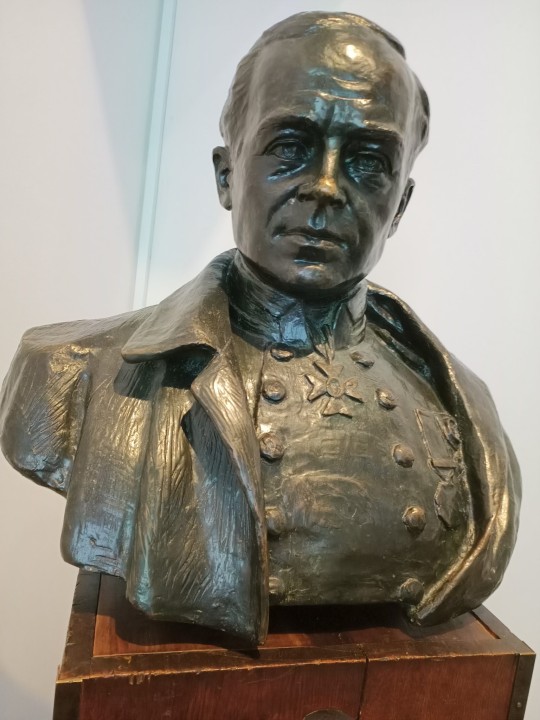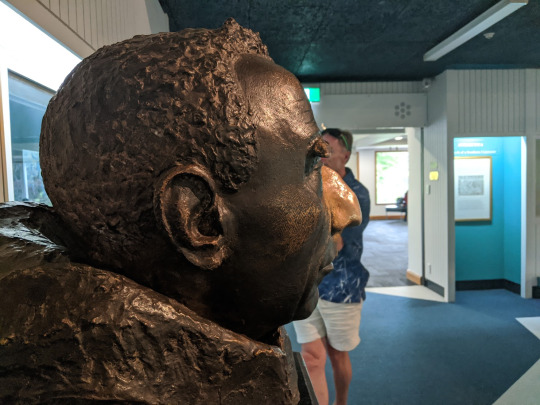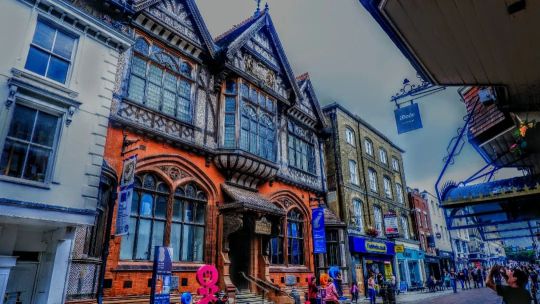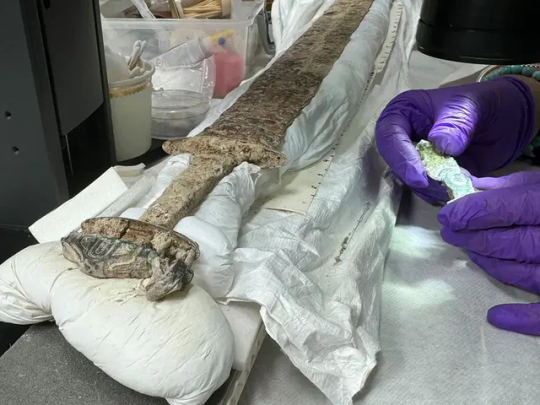#canterbury museum
Explore tagged Tumblr posts
Note
The bust of Scott from the Canterbury Museum is still on display! While the renovation is ongoing they've got a pop-up museum with some favourite pieces on display, and Scott made the cut : ) along with a few other Antarctic ephemera

There he is! Much better lighting than in the museum, too. Sadly he didn't make the cut at the new NPG, though Shackleton is hung in the WWI gallery, for maximum irony!
#captain scott#canterbury museum#christchurch#new zealand#sculpture#kathleen scott#bronze#bust#portrait
25 notes
·
View notes
Text
The best thing about this, to me, is that they mount him just at the right height to encourage rubbing his nose.

I hope this feature is maintained in the renovation ...
where's that post about the noses of dog statues turning gold from all the pats, i found the best statue in the christchurch museum

polar explorer roald amundsen, everyone
420 notes
·
View notes
Text

Canterbury Museum, Christchurch New Zealand (n.d.)
#1900s#photography#Canterbury Museum#Museum#Christchurch#Otautahi#Canterbury#New Zealand#Aotearoa#old photography#edwardian#victorian#victorian era#edwardian era#my archive finds
1 note
·
View note
Text

Canterbury, England
542 notes
·
View notes
Text
Oksidasi Bayam Menghasilkan Racun!
Reaksi Redoks menyebabkan zat gizi dalam bayam berubah menjadi racun. Tak perlu diragukan lagi, bayam adalah sayuran yang sangat bermanfaat bagi tubuh kita. Zat gizi yang terkandung dalam bayam sangat komplit untuk memenuhi asupan gizi yang kita perlukan. Maka tak heran jika dari kecil, orang tua kita selalu menganjurkan kita untuk makan bayam. Bahkan beberapa orang tua harus memutar otak…

View On WordPress
#Acid#American Museum of Natural History#Asia#bahaya bayam#bayam#Blood#Canterbury Regional Council#Carol Bartz#Cheese#Chemical reaction#Coconut oil#Dan (rank)#Drinking water#Dungeons & Dragons gameplay#Ferri#Ferro#Food#Fruit Smoothie Recipes: The Coca-Cola Company#Golden poison frog#Health#Hemoglobin#Iron#Iron deficiency#Kali#manfaat bayam#Meat#Mercury(II) thiocyanate#Methemoglobin#nitrat#Nitrate
0 notes
Text
How Croydon alderman saved 'Golden Book' from the Vikings
Bloody slaughter: imagine one of the big, set-piece scenes from Game of Thrones (minus the dragons and giants), and you get an idea of what the Battle of Aclea might have looked like. The exact site of the battle in the Surrey Hills remains a mystery lost to history SUNDAY SUPPLEMENT: Danish invaders on the rampage, a Wessex king winning a huge battle and the most opulent of all the surviving…

View On WordPress
#Alfred#Anglo-Saxon#Anglo-Saxon Chronicles#Battle of Aclea#Canterbury#Canterbury Cathedral#Codex Aureus#David Morgan#Gospel of St Matthew#King Aethelwulf#Mercia#Stockholm#Stockholm Museum#The Golden Book#Vikings#Wessex
0 notes
Text
NEW ZEALAND - Yuri’s Night 2024 International Space Event at the Air Force Museum.

Yuri’s Night 2024 at the Air Force Museum of NZ, an International Space Celebration; Come along and see Canterbury’s Aerospace on display, completely free; Turn up any time throughout the day (below for some workshop times)
– Planetarium tours – Mars Rover display – Build-Your-Own-Rocket workshops – Static Rocket displays – Giveaways (from stickers to aerospace collectibles) – Astronomical displays – Wind Tunnel exhibit – Build a Shuttle – Send a postcard to space (Really!) – watch a rocket launch (weather dependant) – Touch a piece of rocket that’s returned from Space! – Spot Prizes of cool aerospace swag! – and so much more!
Yuri Gagarin became the first human in Space on April 12th 1961. Fast forward 40 years and “Yuri’s Night” was created as an international space party, celebrating everything aerospace!
– Rocket Workshops at 10am and 2pm (spaces limited) – Rocket Launch at 1pm weather dependant – Planetarium tour numbers subject to space constraints
– Therese Angelo Wing of the Museum (hang a left and go past the cafe upon entering)
Proudly brought to you by the Christchurch Rocketeers, Royal Aeronautical Society of NZ, and the Air Force Museum of New Zealand
Event displays volunteered by: – Christchurch Rocketeers – Royal Aeronautical Society of NZ – Air Force Museum of NZ – Canterbury Astronomical Society – Aerospace New Zealand/ Aotearoa Aerospace Academy – House of Science – UC Aerospace Club – SpacewardBoundNZ – Canterbury Astronomical Society
Yuri’s Night 2024 International Space Event WHERE: 2024-Apr-13 @ 09:30 AM - 2024-Apr-13 @ 04:00 PM WHEN: Air Force Museum of New Zealand Harvard Avenue, Wigram, Christchurch, New Zealand
#yuri's night#new zealand#anniversary of yuri gagarin’s groundbreaking spaceflight#first human mission to leave earth’s atmosphere#firstinspace#first human in space#Christchurch Rocketeers#Royal Aeronautical Society of NZ#Air Force Museum of NZ#Canterbury Astronomical Society#Aerospace New Zealand#Aotearoa Aerospace Academy#House of Science#UC Aerospace Club#SpacewardBoundNZ#workshops#space exploration#12 april#human spaceflight
1 note
·
View note
Text
youtube
For Breakfast - Heavy Horse Museum
#for breakfast#heavy horse museum#maya harrison#sam birkett#joe thompson#omar zaghouani#gail tasker#eden harrison#will eckersley#progressive rock#art rock#canterbury sound#trapped in the big room#ep#2022#Youtube
0 notes
Photo

For World Book Day, here's a throwback to a year & a half ago, and a building that could just as well have come out of a novel, which is used as a public library, and located in a city that is itself the setting of one of the English language's greatest classics. Designed in the Tudor Revival style by A H Campbell and opening 2 years later, the building was primarily funded by Dr James George Beaney, an ordinary man of Canterbury birth who studied medicine before spending a prosperous professional life in Australia. On his death, he left money to the city of Canterbury for an institute to be established to provide amenities for the working class of the city, with the city council choosing to move the existing public museum and library into the new building from the start. Now Grade II listed, it was refurbished in 2009 as part of a wider project to transform the city centre into the vibrant cultural hub that it is today, with the quirky architecture of the Beaney building at once blending with the historic character of the street, while dropping a hint of modernity that almost has the colourful street decoration surrounding it seem a little less out of place than might be expected of a building of older, more formal design. It's playful while still working from timeless principles that retain a degree of human charm and blend in with the surrounding built environment. https://www.instagram.com/p/CpTaBrzo-GQ/?igshid=NGJjMDIxMWI=
#Great Britain#The Beaney#Canterbury#World Book Day#public library#traditional architecture#classical architecture#Gothic revival#High Street#public museum#philanthropy#working class#England#public art gallery#historic building#museum#library#art gallery#heritage#classic design#historical preservation#urban environment#public institution#legacy#Building Better Building Beautiful
1 note
·
View note
Text



Heraldic jupon, or surcoat, belonging to Edward "The Black Prince" of Woodstock, Prince of Wales, hung above his tomb in Canterbury Cathedral (currently at the V&A museum).
Contemporary illustrations of the prince show how it would have appeared in the 14th century: the red lions of the Plantagenets are quartered with the fleurs-de-lys of France, representing his father Edward III's claim to the throne, while the three-pointed label across the top denoted him as the eldest son.
399 notes
·
View notes
Text






NEW PHOTOS KLAXON
Or at least new to me!
The Canterbury Museum in Christchurch has the photos of J.R. Dennistoun, friend of the Expedition and the Kiwi who joined the Terra Nova for her relief trip in 1911, in charge of the mules.
Annoyingly I can't copy/paste the link to the collection directly, but if you go here and click on an object, then scroll down on the object details to "Named collection: DENNISTOUN, James R" you can click on his name and see all his stuff that way. I think some of the photos might have been taken by others, such as the product placement ones, but our pal JRD has been quite good at labelling people!
175 notes
·
View notes
Text

Exceptional Sixth-Century Sword Unearthed in Anglo-Saxon Cemetery in the UK
Archaeologists have uncovered a spectacular sixth-century sword from an Anglo-Saxon cemetery near Canterbury, Kent, in a discovery hailed as one of the most remarkable of its kind. The weapon, distinguished by its exceptional preservation and craftsmanship, is being compared to the famous Sutton Hoo sword found in Suffolk in 1939.
The newly unearthed sword features a silver-and-gilt hilt with intricate decorative patterns and a blade inscribed with runic script. Even the leather-and-wood scabbard, lined with beaver fur, has survived the passage of time. A ring attached to the pommel may symbolize an oath to a king or high-ranking figure, reflecting the weapon’s elite status.
Lead archaeologist Professor Duncan Sayer of the University of Central Lancashire expressed awe at the find. “It’s really incredible, in the top echelons of swords, an elite object in every way. It rivals the swords from Dover and Sutton Hoo,” he said. The Sutton Hoo sword, crafted with gold and cloisonné garnets, is considered a pinnacle of Anglo-Saxon craftsmanship, but this recent discovery stands out for its remarkable condition.

Sutton Hoo Sword.
The cemetery, whose exact location remains undisclosed to protect the site, has so far revealed 12 graves, though researchers estimate it contains up to 200 burials. Male graves have yielded weapons such as spears and shields, while female burials include brooches, buckles, and knives. Notably, the grave containing the sword also held a gold pendant engraved with a serpent or dragon—a type of ornament typically associated with high-status women. Archaeologists suggest it may have been an heirloom or a gift from a female relative.
Other artifacts at the site hint at connections to regions beyond Britain. Scandinavian objects were found in a fifth-century woman’s grave, while items of Frankish origin appear in later burials. These findings illuminate the migration patterns and cultural exchanges following the Roman withdrawal from Britain in the early fifth century.
The excavation has also provided rare insights into Anglo-Saxon funerary customs. Conservator Dana Goodburn-Brown discovered fly pupae on the sword, suggesting the deceased’s body was left exposed for a time before burial, likely to allow loved ones to pay their respects. “So we’re learning something about the funerary practices,” she explained in the upcoming BBC Two series Digging for Britain.
The sword and other artifacts are undergoing conservation and will eventually be displayed at the Folkestone Museum. Prof Alice Roberts, presenter of Digging for Britain, described the site as “an extraordinary Anglo-Saxon cemetery with incredibly furnished graves… The sword is just astonishing.”
By Dario Radley.


#Exceptional Sixth-Century Sword Unearthed in Anglo-Saxon Cemetery in the UK#Canterbury Kent#sword#Sutton Hoo sword#ancient graves#ancient tombs#ancient artifacts#archeology#archeolgst#history#history news#ancient history#ancient culture#ancient civilizations
67 notes
·
View notes
Text

Dame Elisabeth Frink
The Merchant's Tale - Series: The Canterbury Tales II
May and Damyan making love in a tree while Januarie, May's blind husband stands beneath. 1972 Etching and aquatint
British Museum
29 notes
·
View notes
Text
Some readings and resources for further exploration of medieval literature, history, and art
"The Canterbury Tales" by Geoffrey Chaucer
"Beowulf" translated by Seamus Heaney
"The Song of Roland" translated by Dorothy L. Sayers
"The Divine Comedy" by Dante Alighieri
"The Decameron" by Giovanni Boccaccio
"The Book of Margery Kempe" by Margery Kempe
"The Lais of Marie de France" translated by Glyn S. Burgess and Keith Busby
"The History of the Kings of Britain" by Geoffrey of Monmouth
"The Mabinogion" translated by Sioned Davies
"The Romance of Tristan and Iseult" translated by Joseph Bédier
In addition to these literary works, here are some resources for further exploration of medieval history and art:
"A Short History of the Middle Ages" by Barbara H. Rosenwein
"The Civilization of the Middle Ages" by Norman F. Cantor
"The Time Traveler's Guide to Medieval England" by Ian Mortimer
"The Oxford Illustrated History of Medieval Europe" edited by George Holmes
"Medieval Art" by Veronica Sekules
"A Medieval Life : Cecilia Penifader and the world of English peasants before the plague" by Judith Bennett
"The Oxford Handbook of Women and Gender in Medieval Europe" by Judith M. Bennett, Ruth Mazo Karras
The Metropolitan Museum of Art's collection of medieval art and artifacts
The British Library's collection of medieval manuscripts and documents
The Medieval Academy of America's resources and publications on medieval studies
The International Center of Medieval Art's resources and publications on medieval art
These resources should provide a good starting point for further exploration of medieval literature, history, and art.
363 notes
·
View notes
Text

Catedral de Canterbury UK
114 notes
·
View notes
Text

The murder of Thomas Becket at Canterbury. Detail (paint, ink, and gold on paper) by an anonymous artist from the Carrow Psalter, produced in East Anglia ca. 1250. Now in the Walters Art Museum, Baltimore.
#art#art history#Middle Ages#medieval#medieval art#miniature#manuscript illumination#illuminated manuscript#Thomas Becket#Carrow Psalter#English art#13th century art#Walters Art Museum#gore tw#blood tw#violence tw#death tw
216 notes
·
View notes